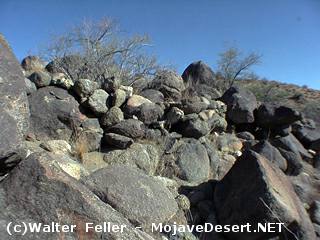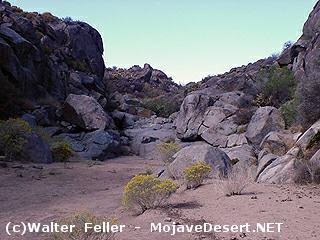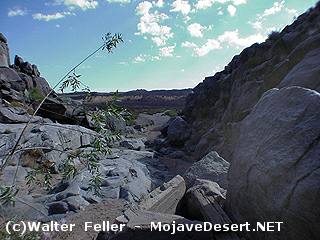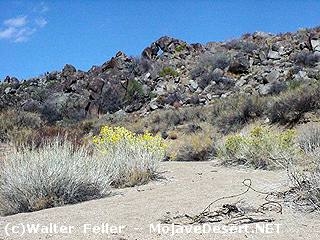Camp Rock Spring
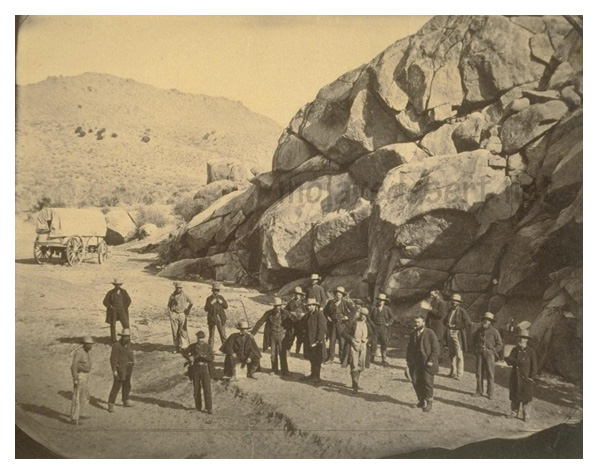
An official Army post, Camp Rock Spring in the Mojave Desert, on the road from Camp Cady to Fort Mohave, Arizona,
located near
Kelso,
San Bernardino County, was established on December 30, 1866. Post returns reveal that Lieutenant
L H. Robinson, 14th Infantry, with Company E, commanded the post from March 16, 1867 until January 2, 1868, after
which it was maintained until May 21, 1868, as a small, intermittently occupied outpost of
Camp Cady.

History
by Colonel Herbert M. Hart, USMC (retired)Executive Director, Council on America's Military Past
"No glory there, nor much for military fame; but true patriots and heroes were they, to submit to such privations," wrote Brevet Brigadier General James T. Rusling in 1866 of Camp Rock Springs. "Too many of our frontier posts are akin to this, and little do members of Congress east, who know only the pomp and circumstance of glorious war,' imagine what army-life out there really is.
"It is a poor place for fuss and feathers, gilt epaulets and brass buttons, and our 'Home Guard,' holiday Militia east, so fond of parading up and down our peaceful streets, with full rations and hotel quarters, would soon acquire for soldiering there a rare and infinite disgust. Yet these are the nurseries of the Army, and from such hard schools we graduated a Grant, Sherman, Sheridan, and Thomas."
Rusling wrote this way in Across America, his unofficial account of an 1866 inspection tour of western forts. In his official report to the Congress he did not go into these same flowery details, nor the barbed comments. "Not considered of much importance," he said of Rock Springs, "and the general route for troops and supplies . . . roundabout, unadvisable, and bad."
Rock Springs' military status began in 1860, as part of the Carleton guard. During the Civil War it was frequently outposted. In 1863, while an outpost of Fort Mojave , its detachment was to keep the fort informed "of any hostile movement that may be made within your knowledge." Rock Springs was to send out "detached scouting parties" in order to "keep the road clear and open for travel in your vicinity."
A one-officer, 20-man patrol made two round trips a month between Fort Mojave and Rock Springs in 1864 "to keep a watch upon the road and see that order is maintained and travelers protected," as district headquarters directed. It appears that the camp was not occupied at this time and this was a substitute measure to protect the road.
Frequent complaints along the road kept the Army busy. In 1863 a citizen at Rock Spring seeing 80 to 100 Indians in the area plus another 300 to 400 at a camp 30 miles to the south. Indians reportedly were terrorizing the few citizens in the area, making off with 24 cattle and threatening "their property and personal security." The report was canceled two days later when it turned out to be a false alarm.
In late 1865, two men built a hut and began mining operations near the site of the post. During their absence, Indians or white, no one could be certain as to which, "burnt the roof from their hut and stole what they could carry off," reported Brevet Brigadier Charles A. Whittier during an inspection trip.
"These two men have been loud in their complaints that while they were developing the resources of the country for the benefit of the government (?), the government does not afford them the protection to which they as American citizens are entitled-and have considered it proper that a full or at least half a company should be sent to this point."
He added, "The removal either of their roof or their mining prospects has caused the two above mentioned citizens to sortie from Rock Springs."
Soon after, a detachment was sent to Rock Springs and it became an official post. "On the desert . . . very disagreeable place for the troops," is how the Secretary of War's 1867 Report describes it.
Building material came easy to the place, and stone buildings and breastworks were built quickly. The lack of forage along the road dictated that infantry replace the cavalry, although some mules and horses were sent to mount the mail wagon escort. The decision was bitterly fought in the light of the relative immobility of an unmounted infantryman versus a mounted Indian, but the facts of life were there. Grain cost $8 a bushel at Rock Springs compared to 80 cents at less isolated posts!
Rock Springs also was to serve as a secondary supply point and even had a post office for a short time. It was supplied from Drum Barracks and San Pedro Depot 250 miles to the west and was advised to "make timely requisitions."
Water was a problem at the post. The spring was poor and irregular and wells had to be sunk a mile westward at "Government Holes." It was to here that a Utah expedition went in 1864 when they found the Rock Springs dry.
The Secretary of War 1867 report told the future: "Camp Rock Springs is to be broken up due to lack of water." By 1868 this had taken place, with roving patrols and the Camp at Marl Springs watching over the area.
TO GET THERE: Rock Springs shows on the Mid Hills 1:62,500 Quadrangle. From Baker; Calif., take Interstate 15 east 28 miles to Valley Wells turnoff. Follow this blacktop road to south through Cima, 17 miles. Continue to south about 4 miles where a gravel road decends from east. Turn left (east), going up Cedar Canyon. In 10 miles, on right will be site of Government Holes and in another mile, site of Camp Rock Springs. This is a good road throughout.
Also see:
Mojave Road
Long ago Mohave indians used a network of pathways to cross the Mojave Desert to reach the Pacific coast from their homes along the Colorado River. ...Camp Rock Spring
Virtual TourNotes:
Proof of an Army visit at Rock Springs is cut into stone there. Most likely a member of the 4th Infantry Regiment, California Volunteers, soldier "Stuart" probably carved this between 1863 and 1866 when that regiment provided many of the troops to protect Government Road. Records show at least one Stuart in regiment during that period. Among scattered rock groups in area is one known as "Morgue" where tradition says bodies were kept in until burial wagon arrived to take them to civilization.
"Camp Rock Springs itself was a forlorn military post, consisting of one officer and perhaps a dozen men, guarding the springs and the road there. The officer was quartered in a natural cave on the hillside, and his men had 'hutted' themselves out on the sand the best the we could," was General Rusling's description in 1866. Although local legends credit certain ruins with being remains of Anne redoubts, identity is uncertain. This ruin is probably typical of redoubt construction, half of it being a dugout, the other half a stone wall high enough so that a man could stand inside. The Storehouse was a cave, both dry and secure.
The "Rock House" at the site of Rock Springs hints how early fort buildings may have looked, or, with time, could have looked. Supposedly built partly with remnants of old fort ruins, this three-room house has walls almost two feet thick. The Whipple Expedition camped at the springs on March 5, 1853, reported that they found "a spring of water oozing out of a rocky ravine ... a few pools were found among the rocks."
